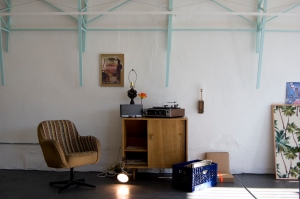“New On The Block: The Museum of Public Fiction,” Artillery Magazine, March / April 2011, Vol. 5, Issue 4, 69.
“New On The Block: The Museum of Public Fiction,” Artillery Magazine, March / April 2011, Vol. 5, Issue 4, 69.
Inhabiting what used to be an old convenience store in Highland Park, Public Fiction, a brand spanking new gallery, embraces every possibility an art space presents, promoting both hybridity in the art it exhibits, and the programming it provides to the public. It does not sell art, and functions a lot like a museum, hosting exhibitions that run for at least three-months at a time. Since there is no pressure to sell work, the gallery is not beholden to the typical exhibition cycle of a commercial gallery, which often has to sell work from one show to pay next month’s rent. This allows the gallery to provide interesting programming, like dances, lectures, concerts, screenings, even secret supper clubs, all designed to contextualize and complicate the show in the gallery. While the space is adamantly multi-functional, it’s also the home of Lauren Mackler, its founder, director and sole financier, who lives in the back and graciously lets visitors to openings chat on her bed and pluck beers from a her bathtub/cooler filled with ice.
Makler moved to LA in January of 2010 after getting her MFA in Graphic Design from RISD. An accomplished designer, she moved to LA knowing that she wanted to use her design skills, as well as her appreciation and knowledge of contemporary art to open a space that in her words, “gives context to the work in it… creating environments combining made as well as found things that are tied to contemporary culture.” And the longer exhibitions allow the shows and the works in them to have “lots of lives and iterations.”

It’s an ambitious endeavor, and it’s not cheap. Makler is not independently wealthy. She funds the space out-of-pocket, living frugally in the Spartan living quarters at the back of the gallery. She has also applied for a small grant from The Awesome Foundation to loft her bed and turn the small space underneath it into a printing press for publishing artist’s books, catalogues, and gallery-related materials. She hopes the gallery will sustain itself in the future with a mix of funding from the sale of publications and income from various events and functions. For now she’s primarily focusing show-to show.
Public Records, the gallery’s first exhibition, opened in October. A play on both an archive and a music store, the show turned the space into a kind of sprawling psychedelic record shop filled with displays of curious objects, some of them “art”, some of them not. A few of the art highlights included: Joshua Callahan’s bricks painted to reference a group of pigeons; Brendan Threadgill’s light-box transparency print from a large format color negative unearthed from underground burial; and Anders Johnson’s strange aqua-colored recreation of an empty record store display rack. Public Fiction’s next show, which opens in February, will deal with issues of religion, mediation, and simplicity, and will completely transform the space into a sort of Mission Church.
With so many galleries closing because of soft sales and rising rents, it seems apropos that new spaces like Public Fiction question the priorities that inform the exhibition of contemporary art. Not to romanticize our economic downturn, but it’s refreshing to think that current constraints will give birth to exhibition spaces like this that prioritize ambitious and risky work over reliable commercial investments, while having fun at the same time.
©2024 Tucker Neel. All rights reserved.